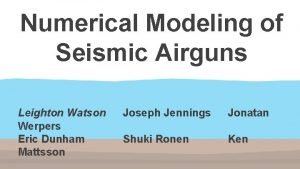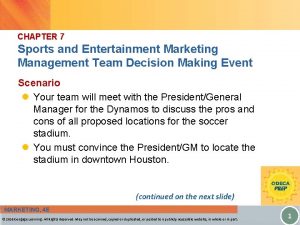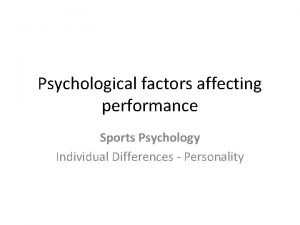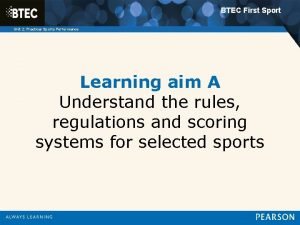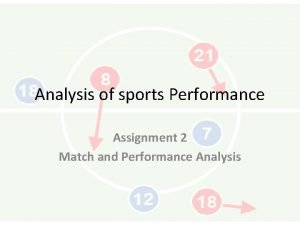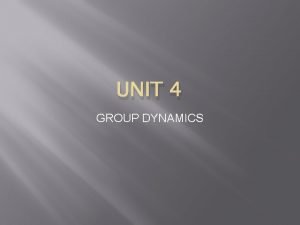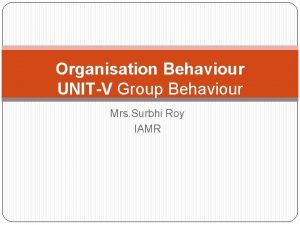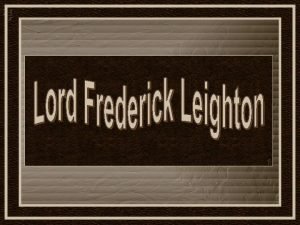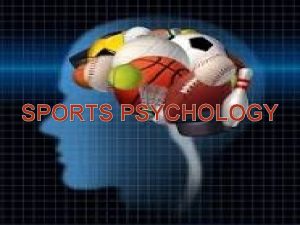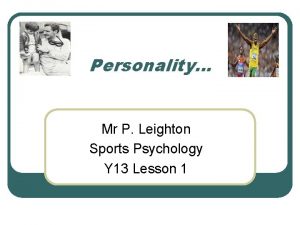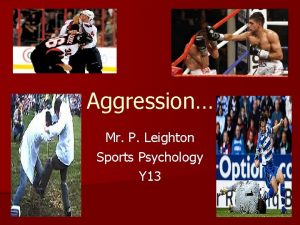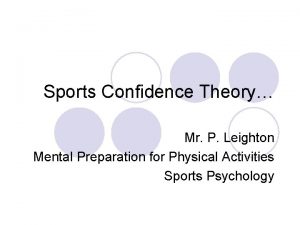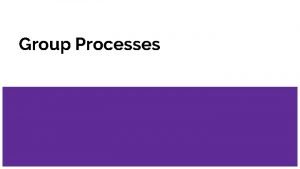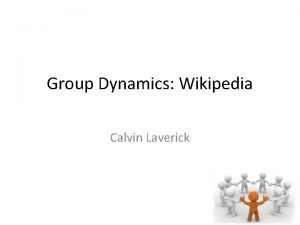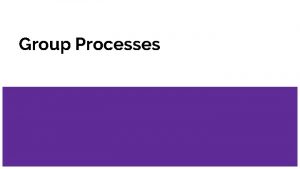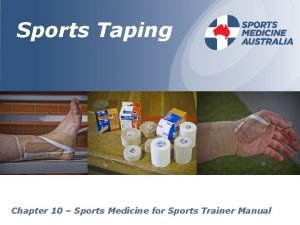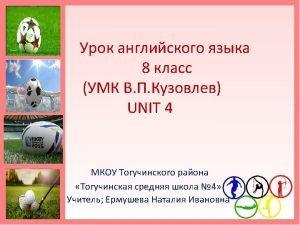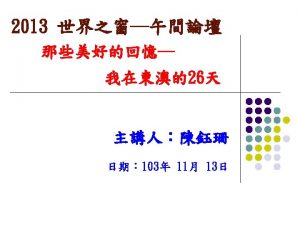Group Dynamics of Performance Mr P Leighton Sports


















- Slides: 18

Group Dynamics of Performance. Mr. P. Leighton Sports Psychology Yr 13

In today’s session… • We will look at the ways GROUP COHESION can be developed. • We will observe the impacts of different group dynamics can have on performance and motivation in pursuit of a healthy, balanced and active lifestyle. • Key theories and contemporary examples linked to these two areas.

So what is Group Cohesion… • Which of these could be called a “Group”? . • Why?

Answers… • A Basketball team, an aerobics session or a PE lessons participants constitute a group. • A football crowd or people running on treadmills in a gym do not constitute a group as they do not have the ability to interact or are not mutually aware of each other. • This is backed up by Mc. Grath (1984) who stated… “Groups are those social aggregates that involve mutual awareness and the potential for interaction”.

Interaction and Interdependence… • Mc. Grath also proposed that groups need to be small enough to allow for interdependence. • Interdependence is a dynamic of being mutually and physically responsible to, and sharing a common set of principles with others. • Carron and Davies (1998) agreed with this and stated that groups should have…

Structured patterns Of communication. Collective Identity. Group Unity The Group… A common goal Shared Purpose

Group Performance: Steiner’s Model… Actual Productivity = Potential Productivity – losses due to faulty processes. OR… (AP = PP – FP) • Actual productivity is the team performance at a given time and refers to the extent of successful interaction. • Potential productivity is the maximum capability of the group when cohesiveness appears at its strongest. • Faulty processes means the factors which can go wrong with team performance. This can detract and impede cohesion and possibly detract from the potential of the team.

Co-ordination losses… (The Ringelmann Effect) • Any breakdown in teamwork is regarded as a co-ordination loss. • This occurs because operational effectiveness of the group as a whole cannot be sustained for the duration of a match. • Maximilien Ringelmann (1861 -1931) had people alone and in groups pull on a rope attached to a strain gauge to measure the pull force. Surprisingly, the total of the group pulls did not equal the sum of the individual pulls - it was less. In contemporary speak, synergy was not created.

Continued… • Team cohesion is more at risk when numbers increase… • What is meant by this? – 5 a Side/ Basketball team: small numbers – Rugby Union: 15 a side: Larger Numbers • The Ringlemann Effect along with Social Loafing are the major faulty processes that prevent a group from becoming a synchronised cohesive unit.

Motivation Losses… (Social Loafing) • Motivation losses relate to an individual who suffers a decrease in motivation during performance causing the player to withdraw effort and “Coast” through a period of play, e. g. Robinho at Manchester City.

Continued… • This loss of motivation and subsequent relaxation can prevent team co-ordination and inhibit team cohesion. • Robinho example: Roberto Mancini stated… “'Does he have a future here? All players try to work hard during the week in training and that is the most important thing. If he wants a future here, then, yes, that is what he has to do”.

The causes of Social Loafing, The Ringlemann Effect and DYSFUNCTIONAL behaviours… • The feeling that others on the team are not trying may cause and individual to make less effort. • “Social Loafing” will arise if a player feels that their performance is not valued or watched by the coach. • A player with low self-confidence will develop a strategy social loafing to protect their self-esteem. • A player who has suffered a negative experience, possibly a loss or a failure, may have the tendency to “loaf”. • A loss of motivation can be linked back to “Avoidance Behaviours”.

Task Cohesion and Social Cohesion… • Task Cohesion is most important for interactive sports such as Hockey. • Task Cohesion relates to how members work together or complete a task successfully. • Social Cohesion is more important in Co-active sports such as Track and Field or Fitness. • Social Cohesion is concerned with formation of groups which provide support and friendship.

Sub-groups… • With larger groups such as a county netball squad there is a possibility that sub-groups can emerge. • This can impede the development of a cohesive unit or team. i. e. Man City Example…

What effects Team Cohesion? Situational Factors. Individual Factors. • Include elements of a specific situation and environment in which the team operates e. g. the time available, interactive or co-active, tradition of leadership. • Group size is also significant as it is more difficult in a large group than a small to facilitate cohesion • This refers to the characteristics of team members. The motivation level and experience in the activity are also examples i. e. Shaun Long joining Hull FC- what will this mean?

What effects Team Cohesion? Leadership Factors. • This involves the style of leadership preferred by the group… – – – Autocratic Democratic Laissez Faire • Leadership styles are determined by… – – – Task Position of the Leader Relationships between all participants. Team Factors. • Team factors include – collective team goals: what do they want as a group? – Good Communication: Is there a barrier to communication? Foreigners/ Sub-groups? – Record of shared success: Arsenal “Invincibles”/ Leeds Rhinos?

Key words from today…

Work for you… • Look over notes from today’s session… • Make notes on “Factors affecting participation in a group or team” (pg. 230) • Make notes on “Group and team effects on behaviour” (pg. 230) up to Leadership on pg. 231.
 Norman leighton
Norman leighton Sonja leighton-kone
Sonja leighton-kone Sanford profile testimonials
Sanford profile testimonials Joseph leighton
Joseph leighton Leighton contractors (asia) limited
Leighton contractors (asia) limited Now group these activities into indoor and outdoor
Now group these activities into indoor and outdoor Dynamics crm online performance
Dynamics crm online performance Factors that affect sports performance
Factors that affect sports performance Optimum sports nutrition
Optimum sports nutrition Sports and entertainment marketing team decision making
Sports and entertainment marketing team decision making Id psychology example
Id psychology example Physiological factors affecting performance
Physiological factors affecting performance Unit 2 practical sports performance
Unit 2 practical sports performance Analysis of sports performance assignment 1
Analysis of sports performance assignment 1 Advanced performance technology
Advanced performance technology Dynamics crm user group
Dynamics crm user group Function of group dynamics
Function of group dynamics Reasons for joining groups in organisational behaviour
Reasons for joining groups in organisational behaviour What is group dynamics in organisational behaviour
What is group dynamics in organisational behaviour



